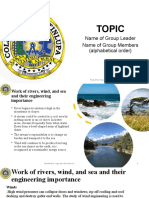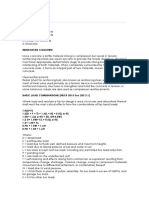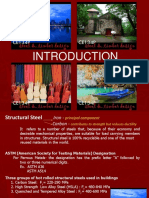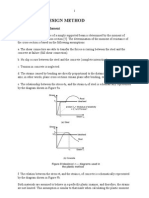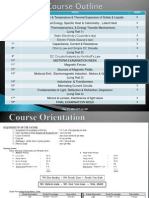Chapter 1 Simple Stresses
Chapter 1 Simple Stresses
Uploaded by
Lalaine RamosCopyright:
Available Formats
Chapter 1 Simple Stresses
Chapter 1 Simple Stresses
Uploaded by
Lalaine RamosOriginal Description:
Copyright
Available Formats
Share this document
Did you find this document useful?
Is this content inappropriate?
Copyright:
Available Formats
Chapter 1 Simple Stresses
Chapter 1 Simple Stresses
Uploaded by
Lalaine RamosCopyright:
Available Formats
1 Normal Stresses Stress is defined as the strength of a material per unit area or unit strength.
It is the force on a member divided by area, which carries the force, formerly express in psi, now in N/mm2 or MPa.
where P is the applied normal load in Newton and A is the area in mm2. The maximum stress in tension or compression occurs over a section normal to the load. Normal stress is either tensile stress or compressive stress. Members subject to pure tension (or tensile force) is under tensile stress, while compression members (members subject to compressive force) are under compressive stress.
Compressive force will tend to shorten the member. Tension force on the other hand will tend to lengthen the member.
2 Problem 104 A hollow steel tube with an inside diameter of 100 mm must carry a tensile load of 400 kN. Determine the outside diameter of the tube if the stress is limited to 120 MN/m2. Solution 104
where:
For bronze cable:
answer Thus, For steel cable:
answer answer Problem 105 A homogeneous 800 kg bar AB is supported at either end by a cable as shown in Fig. P-105. Calculate the smallest area of each cable if the stress is not to exceed 90 MPa in bronze and 120 MPa in steel. Problem 106 The homogeneous bar shown in Fig. P-106 is supported by a smooth pin at C and a cable that runs from A to B around the smooth peg at D. Find the stress in the cable if its diameter is 0.6 inch and the bar weighs 6000 lb.
Solution 106 Solution 105 By symmetry:
For aluminum:
answer For bronze: Problem 107 A rod is composed of an aluminum section rigidly attached between steel and bronze sections, as shown in Fig. P-107. Axial loads are applied at the positions indicated. If P = 3000 lb and the cross sectional area of the rod is 0.5 in2, determine the stress in each section.
answer
answer Problem 108 An aluminum rod is rigidly attached between a steel rod and a bronze rod as shown in Fig. P-108. Axial loads are applied at the positions indicated. Find the maximum value of P that will not exceed a stress in steel of 140 MPa, in aluminum of 90 MPa, or in bronze of 100 MPa.
Solution 107
For steel: Solution 108 answer For bronze:
4 Solution 109 Free body diagram of Joint A
For aluminum:
For wire AB: By sine law (from the force polygon): For Steel:
For safe value of P, use the smallest above. Thus, answer Problem 109 Determine the largest weight W that can be supported by two wires shown in Fig. P-109. The stress in either wire is not to exceed 30 ksi. The cross-sectional areas of wires AB and AC are 0.4 in2 and 0.5 in2, respectively. For wire AC:
For safe load W, answer Problem 110 A 12-inches square steel bearing plate lies between an 8-inches diameter wooden
5 post and a concrete footing as shown in Fig. P-110. Determine the maximum value of the load P if the stress in wood is limited to 1800 psi and that in concrete to 650 psi. For safe load P, Solution 110 For wood: answer Problem 111 For the truss shown in Fig. P-111, calculate the stresses in members CE, DE, and DF. The cross-sectional area of each member is 1.8 in2. Indicate tension (T) or compression (C).
From FBD of Wood:
Solution 111 From the FBD of the truss:
For concrete:
From FBD of Concrete:
At joint F:
At joint D: Stresses: (Stress = Force/Area) answer answer
answer By symmetry
Problem 113 Find the stresses in members BC, BD, and CF for the truss shown in Fig. P-113. Indicate the tension or compression. The cross sectional area of each member is 1600 mm2.
At joint E:
Solution 113 For member BD: (See FBD 01)
Tension
Compression
answer Problem 114 The homogeneous bar ABCD shown in Fig. P-114 is supported by a cable that runs from A to B around the smooth peg at E, a vertical cable at C, and a smooth inclined surface at D. Determine the mass of the heaviest bar that can be supported if the stress in each cable is limited to 100 MPa. The area of the cable AB is 250 mm2 and that of the cable at C is 300 mm2.
answer For member CF: (See FBD 01)
Compression
answer For member BC: (See FBD 02) Solution 114
8 Sfave value of W
answer
Based on cable AB:
Based on cable at C:
9 Shear Stress Forces parallel to the area resisting the force cause shearing stress. It differs to tensile and compressive stresses, which are caused by forces perpendicular to the area on which they act. Shearing stress is also known as tangential stress.
where V is the resultant shearing force which passes through the centroid of the area A being sheared.
answer
Problem 116 As in Fig. 1-11c, a hole is to be punched out of a plate having a shearing strength of 40 ksi. The compressive stress in the punch is limited to 50 ksi. (a) Compute the maximum thickness of plate in which a hole 2.5 inches in diameter can be punched. (b) If the plate is 0.25 inch thick, determine the diameter of the smallest hole that can be punched.
Problem 115 What force is required to punch a 20-mm-diameter hole in a plate that is 25 mm thick? The shear strength is 350 MN/m2. Solution 115 The resisting area is the shaded area along the perimeter and the shear force is equal to the punching force .
Solution 116 (a) Maximum thickness of plate:
10 Based on puncher strength: The bolt is subject to double shear.
Equivalent shear force of the plate Based on shear strength of plate:
answer Problem 118 A 200-mm-diameter pulley is prevented from rotating relative to 60-mm-diameter shaft by a 70-mm-long key, as shown in Fig. P-118. If a torque T = 2.2 kNm is applied to the shaft, determine the width b if the allowable shearing stress in the key is 60 MPa.
answer
(b) Diameter of smallest hole: Based on compression of puncher:
Equivalent shear force for plate Based on shearing of plate:
Solution 118 HideClick here to show or hide the solution
answer Problem 117 Find the smallest diameter bolt that can be used in the clevis shown in Fig. 1-11b if P = 400 kN. The shearing strength of the bolt is 300 MPa.
Solution 117 HideClick here to show or hide the solution
11 Where:
Thus, answer
Problem 119 Compute the shearing stress in the pin at B for the member supported as shown in Fig. P-119. The pin diameter is 20 mm.
shear force of pin at B double shear
Solution 119 From the FBD:
answer
Problem 120 The members of the structure in Fig. P-120 weigh 200 lb/ft. Determine the smallest diameter pin that can be used at A if the shearing stress is limited to 5000 psi. Assume single shear.
12
Solution 120 For member AB: Length, Weight,
Equation (2) Add equations (1) and (2) Equation (1) Equation (2) Length, Weight, From equation (1):
Equation (1) For member BC:
From the FBD of member AB
13
shear force of pin at A From Equation (1),
answer Problem 121 Referring to Fig. P-121, compute the maximum force P that can be applied by the machine operator, if the shearing stress in the pin at B and the axial stress in the control rod at C are limited to 4000 psi and 5000 psi, respectively. The diameters are 0.25 inch for the pin, and 0.5 inch for the control rod. Assume single shear for the pin at B. Thus,
Again from Equation (1),
Thus,
Solution 121
Equation (1) Equation (2)
14 Based on tension of rod (equation 1):
Based on shear of rivet (equation 2):
Safe load P, answer Problem 122 Two blocks of wood, width w and thickness t, are glued together along the joint inclined at the angle as shown in Fig. P-122. Using the free-body diagram concept in Fig. 1-4a, show that the shearing stress on the glued joint is = P sin 2 / 2A, where A is the cross-sectional area. Solution 122 Shear area,
Shear force,
(okay!)
15 Problem 123 A rectangular piece of wood, 50 mm by 100 mm in cross section, is used as a compression block shown in Fig. P123. Determine the axial force P that can be safely applied to the block if the compressive stress in wood is limited to 20 MN/m2 and the shearing stress parallel to the grain is limited to 5MN/m2. The grain makes an angle of 20 with the horizontal, as shown. (Hint: Use the results in Problem 122.)
Based on maximum shearing stress: Shear force:
Shear area:
For safe compressive force use answer
Solution 123 HideClick here to show or hide the solution Based on maximum compressive stress: Normal force:
Normal area:
16 Bearing Stress Bearing stress is the contact pressure between the separate bodies. It differs from compressive stress, as it is an internal stress caused by compressive forces. Part (a): From shearing of rivet:
From bearing of plate material:
answer Part (b): Largest average tensile stress in the plate:
answer Problem 126 The lap joint shown in Fig. P-126 is fastened by four in.-diameter rivets. Calculate the maximum safe load P that can be applied if the shearing stress in the rivets is limited to 14 ksi and the bearing stress in the plates is limited to 18 ksi. Assume the applied load is uniformly distributed among the four rivets.
Problem 125 In Fig. 1-12, assume that a 20-mm-diameter rivet joins the plates that are each 110 mm wide. The allowable stresses are 120 MPa for bearing in the plate material and 60 MPa for shearing of rivet. Determine (a) the minimum thickness of each plate; and (b) the largest average tensile stress in the plates.
Solution 126 Based on shearing of rivets:
Solution 125
17 diameter of bolt Based on bearing of plates: For bearing of yoke: answer
thickness of yoke Safe load P, answer Problem 127 In the clevis shown in Fig. 1-11b, find the minimum bolt diameter and the minimum thickness of each yoke that will support a load P = 14 kips without exceeding a shearing stress of 12 ksi and a bearing stress of 20 ksi.
answer
Problem 128 A W18 86 beam is riveted to a W24 117 girder by a connection similar to that in Fig. 1-13. The diameter of the rivets is 7/8 in., and the angles are each L4 31/2 3/8 in.. For each rivet, assume that the allowable stresses are = 15 ksi and b = 32 ksi. Find the allowable load on the connection. HideSummary of the problem Given: Shape of beam = W18 86 Shape of girder = W24 117 Shape of angles = L4 3-1/2 3/8 Diameter of rivets = 7/8 inch Allowable shear stress = 15 ksi Allowable bearing stress = 32 ksi Required: Allowable load on the connection
Solution 127 HideClick here to show or hide the solution For shearing of rivets (double shear) Solution 128 Relevant data from the table (Appendix B of textbook): Properties of Wide-Flange Sections (W shapes): U.S. Customary Units Designation W18 86 W24 117 Web thickness 0.480 in 0.550 in
18 Given: Diameter of bolt = 7/8 inch Diameter at the root of the thread (bolt) = 0.731 inch Inside diameter of washer = 9/8 inch Tensile stress in the nut = 18 ksi Bearing stress = 800 psi Required: Shearing stress in the head of the bolt Shearing stress in threads of the bolt Outside diameter of the washer
Shearing strength of rivets: There are 8 single-shear rivets in the girder and 4 double-shear (equivalent to 8 single-shear) in the beam, thus, the shear strength of rivets in girder and beam are equal.
Bearing strength on the girder: The thickness of girder W24 117 is 0.550 inch while that of the angle clip L4 3-1/2 3/8 is 3/8 or 0.375 inch, thus, the critical in bearing is the clip.
Bearing strength on the beam: The thickness of beam W18 86 is 0.480 inch while that of the clip angle is 2 0.375 = 0.75 inch (clip angles are on both sides of the beam), thus, the critical in bearing is the beam.
The allowable load on the connection is answer Problem 129 A 7/8-in.-diameter bolt, having a diameter at the root of the threads of 0.731 in., is used to fasten two timbers together as shown in Fig. P-129. The nut is tightened to cause a tensile stress of 18 ksi in the bolt. Compute the shearing stress in the head of the bolt and in the threads. Also, determine the outside diameter of the washers if their inside diameter is 9/8 in. and the bearing stress is limited to 800 psi. HideSummary of the problem Solution 129 Tensile force on the bolt:
Shearing stress in the head of the bolt:
answer
19 Shearing stress in the threads:
answer Outside diameter of washer:
answer
Problem 130 Figure P-130 shows a roof truss and the detail of the riveted connection at joint B. Using allowable stresses of = 70 MPa and b= 140 MPa, how many 19-mm-diameter rivets are required to fasten member BC to the gusset plate? Member BE? What is the largest average tensile or compressive stress in BC and BE?
Solution 130 HideClick here to show or hide the solution At Joint C: (Tension) Consider the section through member BD, BE, and CE:
(Compression)
For Member BC:
20 Based on shearing of rivets: Where A = area of 1 rivet number of rivets, n Tensile stress of member BC (L75 75 6):
say 5 rivets Based on bearing of member: Where Ab = rivet diameter thickness of BC n rivets
answer Compressive stress of member BE (L75 75 13):
answer say 7 rivets Use 7 rivets for member BC. answer Problem 131 Repeat Problem 130 if the rivet diameter is 22 mm and all other data remain unchanged. Solution 131 For member BE: Based on shearing of rivets: Where A = area of 1 rivet number of rivets, n For member BC: (Tension) Based on shearing of rivets: say 5 rivets Based on bearing of member: Where Ab = rivet diameter thickness of BE n rivets say 4 rivets Based on bearing of member:
say 3 rivets say 6 rivets Use 5 rivets for member BE. answer Use 6 rivets for member BC. Relevant data from the table (Appendix B of textbook): Properties of Equal Angle Sections: SI Units Designation L75 75 6 L75 75 13 Area 864 mm2 1780 mm2 For member BE: answer Tensile stress: answer
21 (Compression) Based on shearing of rivets:
say 4 rivets Based on bearing of member:
say 2 rivets Use 4 rivets for member BE Compressive stress: answer
answer
22 Thin-walled Pressure Vessels A tank or pipe carrying a fluid or gas under a pressure is subjected to tensile forces, which resist bursting, developed across longitudinal and transverse sections. TANGENTIAL STRESS, t (Circumferential Stress) Consider the tank shown being subjected to an internal pressure p. The length of the tank is L and the wall thickness is t. Isolating the right half of the tank: section of the tank:
The total force acting at the rear of the tank F must equal to the total longitudinal stress on the wall PT = LAwall. Since t is so small compared to D, the area of the wall is close to Dt
The forces acting are the total pressures caused by the internal pressure p and the total tension in the walls T.
If there exist an external pressure po and an internal pressure pi, the formula may be expressed as:
If there exist an external pressure po and an internal pressure pi, the formula may be expressed as:
It can be observed that the tangential stress is twice that of the longitudinal stress.
LONGITUDINAL STRESS, L Consider the free body diagram in the transverse
23 SPHERICAL SHELL
If a spherical tank of diameter D and thickness t contains gas under a pressure of p = pi - po, the stress at the wall can be expressed as:
answer Longitudinal Stress (transverse section):
Problem 133 A cylindrical steel pressure vessel 400 mm in diameter with a wall thickness of 20 mm, is subjected to an internal pressure of 4.5 MN/m2. (a) Calculate the tangential and longitudinal stresses in the steel. (b) To what value may the internal pressure be increased if the stress in the steel is limited to 120 MN/m2? (c) If the internal pressure were increased until the vessel burst, sketch the type of fracture that would occur. Solution 133 HideClick here to show or hide the solution Part (a) Tangential stress (longitudinal section): answer
Part (b)
24 Total internal pressure: From (a), and thus, shows that tangential stress is the critical. , this
Resisting wall:
answer The bursting force will cause a stress on the longitudinal section that is twice to that of the transverse section. Thus, fracture is expected as shown. answer Problem 135 Calculate the minimum wall thickness for a cylindrical vessel that is to carry a gas at a pressure of 1400 psi. The diameter of the vessel is 2 ft, and the stress is limited to 12 ksi. Solution 135 The critical stress is the tangential stress Problem 134 The wall thickness of a 4-ft-diameter spherical tank is 5/6 inch. Calculate the allowable internal pressure if the stress is limited to 8000 psi. answer Solution 134 Problem 136 A cylindrical pressure vessel is fabricated from steel plating that has a thickness of 20 mm. The diameter of the pressure vessel is 450 mm and its length is 2.0 m. Determine the maximum internal pressure that can be applied if the longitudinal stress is limited to 140 MPa, and the circumferential stress is limited to 60 MPa. Solution 136 Based on circumferential stress (tangential):
25 Problem 137 A water tank, 22 ft in diameter, is made from steel plates that are 1/2 in. thick. Find the maximum height to which the tank may be filled if the circumferential stress is limited to 6000 psi. The specific weight of water is 62.4 lb/ft3. Solution 137
Based on longitudinal stress: Assuming pressure distribution to be uniform:
answer Use answer
26 COMMENT Given a free surface of water, the actual pressure distribution on the vessel is not uniform. It varies linearly from zero at the free surface to h at the bottom (see figure below). Using this actual pressure distribution, the total hydrostatic pressure is reduced by 50%. This reduction of force will take our design into critical situation; giving us a maximum height of 200% more than the h above. Based on actual pressure distribution: Problem 138 The strength of longitudinal joint in Fig. 1-17 is 33 kips/ft, whereas for the girth is 16 kips/ft. Calculate the maximum diameter of the cylinder tank if the internal pressure is 150 psi.
Solution 138 For longitudinal joint (tangential stress):
Total hydrostatic force, F: = volume of pressure diagram Consider 1 ft length
For girth joint (longitudinal stress):
27
Use the smaller diameter,
answer
You might also like
- Simple Stresses From MathalinoDocument58 pagesSimple Stresses From MathalinoGien Lim100% (5)
- ME8391 Engineering Thermo DynamicsDocument402 pagesME8391 Engineering Thermo Dynamicsdasanirban32_4923225100% (1)
- Dynamics Rectilinear - Continuous and ErraticDocument67 pagesDynamics Rectilinear - Continuous and ErraticJJ EnzonNo ratings yet
- CE224 MDB - Module 1: StressDocument8 pagesCE224 MDB - Module 1: Stressaileen eustaquioNo ratings yet
- Rivers Wind SeaDocument7 pagesRivers Wind SeaMarimar CalipayanNo ratings yet
- Analysis of Joints and ConnectionsDocument14 pagesAnalysis of Joints and ConnectionsDave Harrison FloresNo ratings yet
- Mechanics of Deformable BodiesDocument2 pagesMechanics of Deformable BodiesJeff LaycoNo ratings yet
- Principles of Steel Design SetaDocument5 pagesPrinciples of Steel Design Setajek vinNo ratings yet
- Strucl Masangkay Assignment 2 Strucl ElementsDocument9 pagesStrucl Masangkay Assignment 2 Strucl ElementsAbanilla BLouieNo ratings yet
- CEMDEF40 Module 6 - Statically Indeterminate Members and Thermal StressDocument13 pagesCEMDEF40 Module 6 - Statically Indeterminate Members and Thermal StressengrrrrNo ratings yet
- Torsion: Torsion - Introduction To Problems in Which The Stress Is Not Uniform, or Assumed To BeDocument6 pagesTorsion: Torsion - Introduction To Problems in Which The Stress Is Not Uniform, or Assumed To BeChristine Mae TinapayNo ratings yet
- Module 1 Series 1 Aug 16 2021Document20 pagesModule 1 Series 1 Aug 16 2021pamelaNo ratings yet
- Final Quiz - Mechanics of Deformable BodiesDocument1 pageFinal Quiz - Mechanics of Deformable BodieschbarcenalNo ratings yet
- Shear and Moment Diagram - Wikipedia, The Free EncyclopediaDocument10 pagesShear and Moment Diagram - Wikipedia, The Free EncyclopediaPrabhat MishraNo ratings yet
- Enhancement Program TIMBER DESIGNDocument7 pagesEnhancement Program TIMBER DESIGNChristian VillenaNo ratings yet
- 04 ColumnDocument18 pages04 ColumnSamantha Isabel S AguimbagNo ratings yet
- RCD Lesson 1b Flexural Analysis of Beams (Cracking Moment)Document14 pagesRCD Lesson 1b Flexural Analysis of Beams (Cracking Moment)EJ Dela CruzNo ratings yet
- SRB Session5 CentroidsMomentofINERTIADocument4 pagesSRB Session5 CentroidsMomentofINERTIAFullo Flores MarviloneNo ratings yet
- Assignments On Prestressed ConcreteDocument1 pageAssignments On Prestressed Concreteourebooks100% (1)
- 4.) RCD - Midterm Library Work Quiz - Concept and Solutions (1-Way Slab)Document8 pages4.) RCD - Midterm Library Work Quiz - Concept and Solutions (1-Way Slab)Penuel G. Bantog100% (1)
- RCD Lecture 1Document26 pagesRCD Lecture 1Walter CatapangNo ratings yet
- Structural Theory 2Document12 pagesStructural Theory 2GinoOcampo100% (1)
- Torsion Mod1Document49 pagesTorsion Mod1Beveh G SupSupNo ratings yet
- Chapter 1 - Stress and StrainDocument49 pagesChapter 1 - Stress and StrainLuke Nate SarmientoNo ratings yet
- Module 3 STRUCTURAL THEORY MidtermDocument15 pagesModule 3 STRUCTURAL THEORY MidtermMatet MaglipacNo ratings yet
- Problem Set No. 5 PermeabilityDocument5 pagesProblem Set No. 5 PermeabilityJed YasisNo ratings yet
- Reporter 16 Concrete Pavement Behavior and CharacteristicsDocument25 pagesReporter 16 Concrete Pavement Behavior and CharacteristicsVINCENT NICOLO PALMA BULURANNo ratings yet
- Indetermine StructureDocument8 pagesIndetermine Structuremaloy100% (1)
- Chapter 9 - Centroid and CGDocument24 pagesChapter 9 - Centroid and CGnishant361No ratings yet
- CE 108 RCD SyllabusDocument12 pagesCE 108 RCD SyllabusJoab Gabriel Elegado CalumpianoNo ratings yet
- Module 1.0-SIMPLE STRESS - Axial-NormalDocument20 pagesModule 1.0-SIMPLE STRESS - Axial-NormalJoseph Berlin JuanzonNo ratings yet
- 2 MEC32-1 REVIEW OF MEC30 (Robles)Document16 pages2 MEC32-1 REVIEW OF MEC30 (Robles)John BurnsideNo ratings yet
- New Format For ACCRE Level 4-CE CORRELATIONDocument8 pagesNew Format For ACCRE Level 4-CE CORRELATIONMarbel PerezNo ratings yet
- Mechanics of MaterialsDocument21 pagesMechanics of MaterialsUbaid Ahmed Mughal100% (1)
- Arch 631Document17 pagesArch 631althea guanzonNo ratings yet
- RCD IntroductionDocument24 pagesRCD IntroductionJohn Mortel AparicioNo ratings yet
- IM BSCE 3 - Hydraulics 1 Chapter 1 2021-2022Document36 pagesIM BSCE 3 - Hydraulics 1 Chapter 1 2021-2022acurvz2005No ratings yet
- 1.1 - Introduction - Simple StressesDocument24 pages1.1 - Introduction - Simple StressesGelcie Maligaya0% (1)
- Field Exercise No. 4Document3 pagesField Exercise No. 4Bambi InjangNo ratings yet
- CEMDEF40 Module 2 - Simple StressesDocument27 pagesCEMDEF40 Module 2 - Simple StressesengrrrrNo ratings yet
- 5 CE131P - Beams and Frames - Shear and Bending Moment (Robles)Document23 pages5 CE131P - Beams and Frames - Shear and Bending Moment (Robles)Marion Frea PlazoNo ratings yet
- Strength of MaterialsDocument17 pagesStrength of MaterialskalpanaNo ratings yet
- MEGA Review-Module-32-Strength-of-Materials-3Document1 pageMEGA Review-Module-32-Strength-of-Materials-3Study BuddiesNo ratings yet
- Structural Theory 1 (Part 3)Document14 pagesStructural Theory 1 (Part 3)GinoOcampo100% (1)
- QB ARM401Document6 pagesQB ARM401Mahi PathakNo ratings yet
- Problem Set Strength of MaterialsDocument2 pagesProblem Set Strength of MaterialsRoku Dee22% (9)
- Syllabus OBE CDIO Format Specialized413B JCCDocument9 pagesSyllabus OBE CDIO Format Specialized413B JCCKenneth Macagba IsipNo ratings yet
- Module 1 Fluid PropertiesDocument7 pagesModule 1 Fluid Propertiestrimyn cloudNo ratings yet
- Moment Area TheoremDocument3 pagesMoment Area TheoremzidaaanNo ratings yet
- Shear and Moment in BeamsDocument1 pageShear and Moment in BeamsMariz Ellaine BaltazarNo ratings yet
- Simple StressDocument43 pagesSimple StressKeith R SimblanteNo ratings yet
- ES5 Mechanics of Materials SampleProblems ShearDocument1 pageES5 Mechanics of Materials SampleProblems ShearFrederick Jaradal Petallar50% (2)
- Plate No. 2: Analysis and Design of Flexural MembersDocument12 pagesPlate No. 2: Analysis and Design of Flexural MembersIrene B. QuiñonesNo ratings yet
- A. Hydrostatic Force On Plane Surface: 1. FormulaDocument20 pagesA. Hydrostatic Force On Plane Surface: 1. FormulaKim Kelley AngNo ratings yet
- INTRODUCTIONDocument19 pagesINTRODUCTIONjohn devonNo ratings yet
- Solved Problems Normal StressDocument3 pagesSolved Problems Normal StressA'TINSB19No ratings yet
- Practice Problems Steel DesignDocument4 pagesPractice Problems Steel DesignMJ Dela CruzNo ratings yet
- MCE01a QUIZ 2Document6 pagesMCE01a QUIZ 2venom thecatNo ratings yet
- Steel DesignDocument5 pagesSteel DesignLYNSER CORONEL ABANZADONo ratings yet
- ECS448 - Topic 5 (Deformation - Virtual Work For Frame & Truss)Document33 pagesECS448 - Topic 5 (Deformation - Virtual Work For Frame & Truss)darwishshahrir__No ratings yet
- Plastic Design MethodDocument8 pagesPlastic Design MethodBhaskar ReddyNo ratings yet
- RC Beam Design Bs v1.1 - Free Lite VersionDocument3,051 pagesRC Beam Design Bs v1.1 - Free Lite VersionLalaine RamosNo ratings yet
- Item To Be Estimated Calculations Quantity Length Width: SlabsDocument8 pagesItem To Be Estimated Calculations Quantity Length Width: SlabsLalaine RamosNo ratings yet
- Construction Materials and Testing (L) : New Era UniversityDocument5 pagesConstruction Materials and Testing (L) : New Era UniversityLalaine RamosNo ratings yet
- Project 2Document7 pagesProject 2Lalaine RamosNo ratings yet
- Construction Materials and Testing (L) : New Era UniversityDocument9 pagesConstruction Materials and Testing (L) : New Era UniversityLalaine RamosNo ratings yet
- Method of JointsDocument11 pagesMethod of JointsLalaine Ramos100% (1)
- The Civil Engineering Licensure Examination SyllabiDocument9 pagesThe Civil Engineering Licensure Examination Syllabiapi-281795875No ratings yet
- Region 1gffgfgDocument9 pagesRegion 1gffgfgLalaine RamosNo ratings yet
- Biag Ni Lam-Anf SummaryDocument2 pagesBiag Ni Lam-Anf SummaryLalaine Ramos60% (10)
- Landslide On Cherry Hills SubdivisionDocument7 pagesLandslide On Cherry Hills SubdivisionLalaine RamosNo ratings yet
- Common Plumbing ProblemsDocument9 pagesCommon Plumbing ProblemsLalaine RamosNo ratings yet
- Analysis and Interpretation of Data and ResultDocument4 pagesAnalysis and Interpretation of Data and ResultLalaine RamosNo ratings yet
- LF Thermal ExpansionDocument31 pagesLF Thermal ExpansionLalaine RamosNo ratings yet
- Singly Reinforced BeamDocument3 pagesSingly Reinforced BeammariyaNo ratings yet
- Chapter 14【Solids and Fluids】Document20 pagesChapter 14【Solids and Fluids】陳慶銘No ratings yet
- 4 SyllabusDocument44 pages4 SyllabusBb KNo ratings yet
- Simulation of Food Drying Processes by Computational Fluid Dynamics (CFD) Recent Advances and ApproachesDocument49 pagesSimulation of Food Drying Processes by Computational Fluid Dynamics (CFD) Recent Advances and ApproachesJJ Monjardín-GámezNo ratings yet
- Problem Sheet 3Document2 pagesProblem Sheet 3balochfrahan.2003No ratings yet
- Dicussion On Structural Design of Steel Pipe Support StructuresDocument3 pagesDicussion On Structural Design of Steel Pipe Support Structuresapirakq100% (1)
- Strength of Materials: Lecture-9: Axial Deformation of Axially Loaded Composite BarsDocument23 pagesStrength of Materials: Lecture-9: Axial Deformation of Axially Loaded Composite BarsAshraf Hussain BelimNo ratings yet
- Chapter 3c Screwed JointsDocument17 pagesChapter 3c Screwed JointsAdugna GosaNo ratings yet
- Design of Load Carrying Shaft With One Pulley Supported by Two Bearings - Engineers EdgeDocument3 pagesDesign of Load Carrying Shaft With One Pulley Supported by Two Bearings - Engineers EdgearsanioseNo ratings yet
- Shear Key - 44.5mDocument10 pagesShear Key - 44.5mPrashant JhaNo ratings yet
- Air Classifier ArticleDocument16 pagesAir Classifier ArticlePeyman KhNo ratings yet
- Gausss Law and Potential HW KeyDocument10 pagesGausss Law and Potential HW KeyRanko KamilNo ratings yet
- Sri Chaitanya Educational Institutions, Ap: Raman Bhavan:: VisakhapatnamDocument4 pagesSri Chaitanya Educational Institutions, Ap: Raman Bhavan:: VisakhapatnamGadde Gopala KrishnaNo ratings yet
- Mechanical Engineering: Assistant ProfessorDocument30 pagesMechanical Engineering: Assistant ProfessorAira EnejosaNo ratings yet
- Hydraulics FormulaDocument1 pageHydraulics FormulalifeadventureNo ratings yet
- CFD Estimation of Heat Transfer Enhancement On A Cooling Pipe in Underground Railway TunnelsDocument16 pagesCFD Estimation of Heat Transfer Enhancement On A Cooling Pipe in Underground Railway TunnelsY TingNo ratings yet
- GATE Strength of Materials BookDocument12 pagesGATE Strength of Materials BookMims1267% (6)
- Markscheme SL Paper 3Document32 pagesMarkscheme SL Paper 3joelkota018No ratings yet
- Learning Target (Daily)Document4 pagesLearning Target (Daily)Yousif Jamal Al Naqbi 12BENo ratings yet
- Motion Lesson - 1Document15 pagesMotion Lesson - 1samsonNo ratings yet
- Single Span Composite Precast Beam and Deck Bridge Design ManualDocument26 pagesSingle Span Composite Precast Beam and Deck Bridge Design Manualani4576100% (1)
- Mechanical Vibration Kme - 057: Frequency Calculation Equivalent SystemDocument14 pagesMechanical Vibration Kme - 057: Frequency Calculation Equivalent Systemprashant uttamNo ratings yet
- PHYS 1 Worksheets - QXDDocument3 pagesPHYS 1 Worksheets - QXDMeeta NurkunasegranNo ratings yet
- AP Workbook 5-E-1Document3 pagesAP Workbook 5-E-1Steve PeraltaNo ratings yet
- In The Previous WeekDocument2 pagesIn The Previous Weekever quiroNo ratings yet
- Apdx4Document2 pagesApdx4ronalddelacruzNo ratings yet
- Calculation Sheet: Design of Splice For BeamDocument6 pagesCalculation Sheet: Design of Splice For BeamTOM YEENo ratings yet
- Poedts MHD Theory PDFDocument148 pagesPoedts MHD Theory PDFhiren_mistry55No ratings yet




